
Neighborhood and Built Environment
Introduction
Neighborhood and built environment explores the connection between the environment where a person lives and their health, quality of life, and opportunities to make healthy choices. The context in which residents live profoundly impacts all aspects of their health.
Throughout Mesa County, there are a variety of institutions and services that support and improve residents’ environmental context. These include grocery stores, libraries, parks and green spaces, fire and emergency services, and law enforcement.
These resources improve resident opportunities for healthy choices, capability to meet their basic needs, and safety from potential hazards. The challenge is to provide equitable access to all county residents.
Neighborhood Services and Resources
In the 2022 Tell Us Community Survey, residents provided feedback on their satisfaction with access to services and resources in their neighborhoods. 62% of Mesa County residents indicated that Mesa County is a good place to live, but for many residents their satisfaction with their community is heavily impacted by their access to services and resources.
AGREEMENT WITH: MESA COUNTY IS A GOOD PLACE TO LIVE
AGREEMENT WITH: MESA COUNTY IS A GOOD PLACE TO LIVE
| Agree | |
|---|---|
| All Others | 64.3 |
| Redlands | 67.0 |
| Grand Junction | 64.7 |
| Fruitvale | 52.1 |
| Fruita | 59.7 |
| Clifton | 47.0 |
| Overall | 62.3 |
MESA COUNTY IS A GOOD PLACE TO LIVE.

County-wide, respondent satisfaction with neighborhood services and resources widely varied from consistent satisfaction with the number and quality of parks and trails to deep dissatisfaction with the availability of affordable housing. Unsurprisingly, satisfaction with access to these services and resources correlated with how satisfied residents were with their neighborhoods overall, but that connection was far greater among lower-income residents.
SATISFIED WITH MESA COUNTY NEIGHBORHOOD SERVICES AND RESOURCES (2022)
Basic Conditions

SATISFIED WITH MESA COUNTY NEIGHBORHOOD SERVICES AND RESOURCES (2022)
Basic Conditions
| Amenity | Percent Satisfactied |
|---|---|
| Grocery Store Access | 59% |
| Quality Health Care Access | 49% |
| Overall Safety and Security | 47% |
| Quality Child Care Access | 17% |
| Affordable Housing Availability | 11% |
SATISFIED WITH MESA COUNTY NEIGHBORHOOD SERVICES AND RESOURCES (2022)
Transportation

SATISFIED WITH MESA COUNTY NEIGHBORHOOD SERVICES AND RESOURCES (2022)
Transportation
| Tranportation | Percent Satisfactied |
|---|---|
| Bikeability | 49% |
| Walkability | 44% |
| Road Conditions | 28% |
SATISFIED WITH MESA COUNTY NEIGHBORHOOD SERVICES AND RESOURCES (2022)
Parks and Trails

SATISFIED WITH MESA COUNTY NEIGHBORHOOD SERVICES AND RESOURCES (2022)
Parks and Trails
| Tranportation | Percent Satisfactied |
|---|---|
| Number of Parks and Trails | 66% |
| Quality of Parks and Trails | 66% |
Unsurprisingly, satisfaction with access to these amenities correlated with how satisfied residents were with their neighborhoods overall, but that connection was far greater among lower-income residents.
We considered the relationship between a respondent’s satisfaction with nearby services and resources and their satisfaction with their neighborhood. Proximity to neighborhood services and resources has a stronger impact on respondents’ rating of their neighborhood if they earn less than $50,000 in annual household income than if they earn more than $50,000.
Location is less of a barrier to accessing services and resources for residents with higher incomes. If their neighborhood lacks a service or resource, they can usually drive to access it in a nearby neighborhood. However, location can pose a significant barrier for low-income residents who lack the transportation or flexibility in work schedules to access services and resources that are located farther away.
Percent of Residents who like their neighborhood base on income and satisfaction with conditions (2022)
| When Income < 50K |
When Income > 50K |
|
|---|---|---|
| When Satisfied with Resources and Amenities | 75% | 82% |
| When not Satisfied with Resources and Amenities | 47% | 68% |
| Difference When Satisfied vs When Not Satisfied | 32% | 14% |
Rural and Urban Areas
Seven in eight Mesa County residents live in an urban area, and one in eight live in a rural area. In general there are fewer services in rural areas. This includes less access to grocery stores, fewer medical services, and longer response time for emergency services. This necessitates higher transportation needs for daily living. Nevertheless, people who live in rural areas of the county have a higher level of satisfaction with their neighborhoods. 82% of rural residents were satisfied compared to 67% of urban residents.
Census defined Grand Junction Urban Area
For many residents, the rural character of a region may be more important than population density. Some people who live between Clifton and Palisade or some areas north of I-70 might be surprised to find themselves designated as urban by the Census.
Official definitions of urban and rural are important for some support programs and funding decisions. Recently, Clifton was re-designated from rural to urban by the USDA, impacting eligibility for funding such as USDA housing programs that target rural areas. Fruita’s designation is also under review based on the rural character of the community, which would potentially open new funding opportunities. (2023 Rural Area Review Notices, p. 8)
Housing
Housing impacts many aspects of life and health including safety, stability, and social connection. Nearly a third of all households pay 30% or more of their income for housing, a cost burden that can limit families’ ability to direct resources to other essential expenses.
Historically, this problem has most affected lower income households, but now the problem impacts households with average and higher incomes, as well. In the 2022 Tell Us Community Survey, only 11% of residents indicated that they were satisfied with the availability of affordable housing.
Housing Cost Trends
The cost of purchasing a home in Mesa County has increased significantly in recent years. Combined with recent high mortgage interest rates, this means purchasing a starter home is currently the most challenging it has been since the 1980s.
Monthly rental costs have also increased notably, although less than starter home costs. However, the median income for the Grand Junction urban area has not kept pace with the housing cost increases. This means the cost of housing has become a burden for an increasing share of Mesa County households.
The biggest change in starter home prices took place in 2022. Annual increases in starter house price have outpaced increases in median income every year since 2016. Annual increases in rent cost have been higher than increases in median income in five out of seven years.
Percent Increase since 2015 of Housing Costs and Median Income, Mesa County
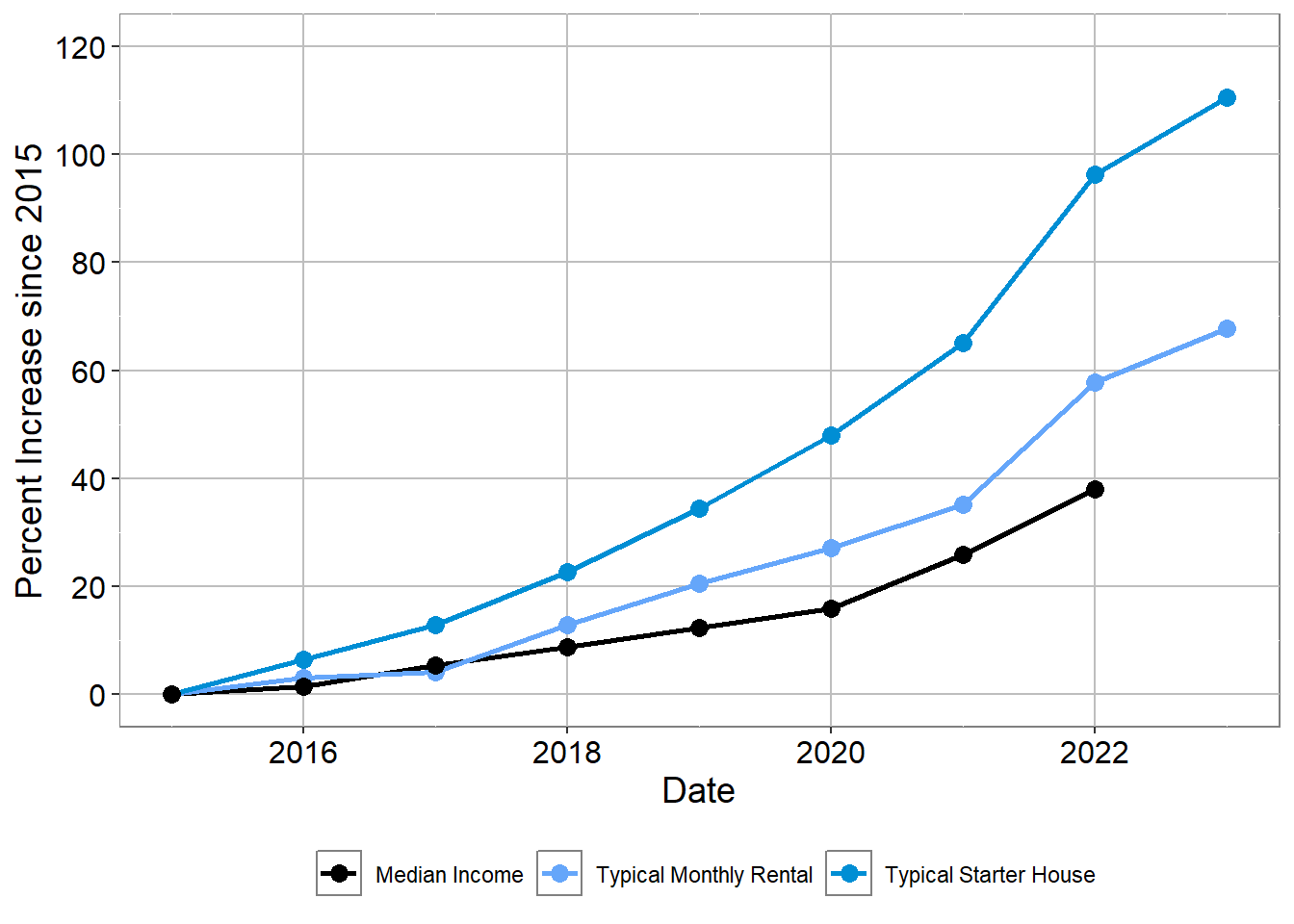
Percent Increase since 2015 of Housing Costs and Median Income, Mesa County
Warning: Values from `relative` are not uniquely identified; output will contain
list-cols.
• Use `values_fn = list` to suppress this warning.
• Use `values_fn = {summary_fun}` to summarise duplicates.
• Use the following dplyr code to identify duplicates.
{data} |>
dplyr::summarise(n = dplyr::n(), .by = c(name, Year)) |>
dplyr::filter(n > 1L)| 2015 | 2016 | 2017 | 2018 | 2019 | 2020 | 2021 | 2022 | 2023 | |
|---|---|---|---|---|---|---|---|---|---|
| Typical Starter House | 0.0% | 6.0% | 13.0% | 23.0% | 34.0% | 48.0% | 65.0% | 96.0% | 111.0% |
| Typical Monthly Rental | 0.0% | 3.0% | 4.0% | 13.0% | 21.0% | 27.0% | 35.0% | 58.0% | 68.0% |
| Median Income | 0.0% | 2.0% | 5.0% | 9.0% | 12.0% | 16.0% | 26.0% | 38.0% | 45.0%, NA% |
The biggest change in home prices took place in 2022, but annual increases in starter house price have outpaced increases in median income every year since 2016, and annual increases in rent cost have been higher than increases in median income in five out of seven years.
Yearly Percent Change of Housing Costs and Median Income, January Year over Year Percent Change

Yearly Percent Change of Housing Costs and Median Income, January Year over Year Percent Change
Warning: Values from `change` are not uniquely identified; output will contain
list-cols.
• Use `values_fn = list` to suppress this warning.
• Use `values_fn = {summary_fun}` to summarise duplicates.
• Use the following dplyr code to identify duplicates.
{data} |>
dplyr::summarise(n = dplyr::n(), .by = c(name, Year)) |>
dplyr::filter(n > 1L)| 2016 | 2017 | 2018 | 2019 | 2020 | 2021 | 2022 | 2023 | |
|---|---|---|---|---|---|---|---|---|
| Typical Starter House | 6.4 | 6.05 | 8.66 | 9.6 | 10.08 | 11.63 | 18.89 | 7.23 |
| Typical Monthly Rental | 3.12 | 1.04 | 8.35 | 6.78 | 5.5 | 6.21 | 16.74 | 6.43 |
| Median Income | 1.52 | 3.8 | 3.29 | 3.16 | 3.21 | 8.7 | 9.58 | 5.01, NA |
New Housing
Between 2017 and 2022, Mesa County added a total of 5,578 new housing units. 85.4% of these units have been added in the urban areas of Mesa County.
NEW HOUSING UNITS BY TYPE MESA COUNTY 2017-2022
| Urban/Rural | Type | 2017 | 2018 | 2019 | 2020 | 2021 | 2022 | Row Totals |
|---|---|---|---|---|---|---|---|---|
| Rural | Single Family Residence | 105 | 117 | 120 | 168 | 188 | 112 | 810 |
| Urban | Single Family Residence | 542 | 600 | 521 | 560 | 645 | 493 | 3361 |
| Urban | Townhouse Unit | 73 | 92 | 79 | 66 | 114 | 50 | 474 |
| Urban | Duplex/Triplex Unit | 14 | 6 | 0 | 9 | 10 | 8 | 47 |
| Urban | Multi-Fam 4-8 Unit | 0 | 6 | 8 | 0 | 17 | 62 | 93 |
| Urban | Multi 9+ Unit | 20 | 49 | 45 | 299 | 217 | 163 | 793 |
| Total Units | All Units | 754 | 870 | 773 | 1102 | 1191 | 888 | 5578 |
NEW HOUSING UNITS LOCATION 2017-2022
Rural Areas; Urban Areas; New housing
Homelessness
Homelessness is a common concern and a high priority for intervention among Mesa County community members. Residents are increasingly experiencing homelessness and other types housing instability. Services for people experiencing homelessness are frequently beyond capacity, lacking adequate fiscal resources or staff to serve the increase in need.
Addressing homelessness in Mesa County will require:
- having the right stakeholders at the table,
- finding funding,
- providing data to show the scope and scale of the issue,
- advocating for policy change, and
- providing community education to enhance support for services and to reduce stigma.
The 2021 Grand Valley Housing Survey identified and quantified housing needs across the Grand Valley. The survey results informed strategy and recommendations for community leaders that can guide future policy decisions related to housing.
Here are some of the key findings from the survey:
- One in five households with income less than $35,000 would like to live on their own or with fewer people but cannot afford it.
- One in four households who had moved in the last five years did not wish to move but had to.
- Respondents expressed a strong desire for the housing stock to accommodate a wide range of residents including those living on a fixed income, low- and moderate-income families, and residents with mobility challenges.
In 2023, the City of Grand Junction and community partners conducted an Unhoused Needs Assessment that aimed to identify strategies and actions to address needs among residents experiencing housing insecurity. The assessment estimates that at the time of publication, there were 2,300 individuals experiencing homelessness in the Grand Junction area.
Resident Priorities & Concerns
Housing Options & Availability
Affordable housing and a diversity of housing options are priorities for residents in Mesa County. In the 2022 Tell Us Community Survey, one in four residents identified the facilitation of diverse housing development as a priority for county leadership.
While the great majority of Mesa County residents feel there is not enough affordable housing, this is even more pronounced among younger adults who are often entering the market as first-time homebuyers. Only 7% of residents under 40 said they were satisfied with affordable housing availability.
This sentiment was reflected in the 2022 Mesa County Master Plan survey as well. A significant majority of residents, nearly three in four, said there were too few starter homes available, and about half said there are too few apartments and too little housing for seniors. By contrast, 97% of residents said there are enough or too many higher-end homes available.
Dissatisfaction with housing availability (2022), “Mesa County has too few …”

Dissatisfaction with housing availability (2022), “Mesa County has too few …”
| Starter Homes | Apartments | Housing for Seniors | Townhomes/Condos | Mobile Homes | Higher-end Homes |
|---|---|---|---|---|---|
| 73.0% | 51.0% | 50.0% | 43.0% | 9.0% | 3.0% |
Urban Expansion
Though residents share broad consensus that housing availability in Mesa County is inadequate in various ways, on the whole they also prefer limiting housing expansion primarily to urban areas.
According to the 2022 Mesa County Master Plan survey, the quality of the natural environment and outdoor recreation are some of the most highly rated and valued characteristics of life in Mesa County, and the vast majority of residents want these to be protected for the future. The majority of residents agreed that rural areas should remain rural and that new development should minimize impacts to natural areas and agricultural land.
While there is wide support for limiting expansion into rural areas, this type of expansion could be useful in helping to resolve existing housing issues. Local governments will need to incorporate a balance of both of these resident priorities as they work to address housing access throughout the county.
Resident’s Agreement with the statment …

Food Access
According to research by Feeding America, in 2021, 11.1% of Mesa County’s population was likely experiencing food insecurity, based on economic and demographic factors. That equates to approximately 17,000 individuals. Within that group, one in four likely met criteria for food assistance such as SNAP and WIC, but three in four likely did not due to earning above the income limits for eligibility.
In the 2023-2024 school year, 53% of Mesa County students attending a local district qualified for free or reduced lunch. Since this is an opt-in, income-based qualification, it likely does not fully capture students whose families are struggling with economic self-sufficiency, and may experience food insecurity.
In District 51’s 2023 Panorama student survey, 93% of 3rd to 5th grade students and 97% of 6th to 12th grade students indicated that they have enough food at home to eat breakfast, lunch, and dinner.
In the 2023 Colorado Health Access Survey, 8.4% of Mesa County residents indicated that in the past 12 months, they had eaten less than they felt they should because there wasn’t enough money for food. Statistically, this rate is similar to the 2021 rate of 8.8% and the 2019 rate of 9.2%, though it is possible that it reflects the beginning of a downward trend that would be more clear with additional data.
RESIDENTS WITH FOOD INSECURITY, MESA COUNTY

RESIDENTS WITH FOOD INSECURITY, MESA COUNTY
| Year | Percent with food insecurity |
|---|---|
| 2019 | 9.2 |
| 2020 | 8.8 |
| 2021 | 8.4 |
Food insecurity is highly impacted by access to nutritious food. In urban areas, marked gray in the map below, target benchmarks for distance from homes to a grocery store that provides staple foods and fresh fruits and vegetables range from one mile to two miles. Clearly, there are urban areas of Mesa County that fall outside both of these benchmarks.
Access to neighborhood amenities like grocery stores is more important for low-income residents than moderate- and high-income residents. Some communities outside the radius may feel the lack of a nearby grocery store more acutely based on their economic resources.
MESA COUNTY ACCESS TO GROCERY STORES, 2023
Information Access
Libraries
Mesa County Libraries provides a variety of physical and digital resources to Mesa County residents through their eight branches and website. In 2023, Mesa County Libraries circulated 1.3 million items. Computer use increased from 51,000 users in 2022 to 51,530 users in 2023 and wireless use increased from 375,000 to 379,000 sessions.
High-Speed Internet Access
Internet access influences a person’s opportunities in education, employment, and healthcare access. The most common barriers to internet access are infrastructure and affordability, barriers that most impact rural and low-income households.
According to the Census American Community Survey, in 2022, 10% of Mesa County households did not have a subscription to broadband internet services, which was similar to the statewide rate. Among Mesa County households with less than $20,000 in household income, 27% did not have a subscription to broadband internet services, compared to 31% in that income group nationally. This disparity is commonly referred to as the “digital divide” and has the potential to worsen pre-existing inequities.
In the 2022 Tell Us Community Survey, about 70% of respondents indicated they had adequate home internet access. Nonetheless, over 80% of residents support Mesa County leadership investing in better internet services and bringing more internet providers to the area.
Public Safety
A wide range of local agencies provide public safety in the Mesa County community, including law enforcement, fire and emergency services (EMS), code compliance, and more. The capacity and effectiveness of Mesa County’s public safety infrastructure is critical in mitigating the impacts of crime, unsafe or illegal land use, and other physical hazards and crises. Overall, the majority of Mesa County residents value this effort as highly important and put a great deal of trust in these institutions.
Law Enforcement and Emergency Response
Public safety is a top priority for residents in Mesa County. In the 2022 Tell Us Community Survey, 38% of residents identified promoting public safety as an area they’d prefer for community leaders to prioritize. This was the second most commonly selected priority after improving the K-12 education system.
Across the county, half of residents indicated they are satisfied with the responsiveness of local law enforcement in the area in which they live, and a similar share said they personally trust law enforcement in Mesa County.
Residents’ satisfaction with law enforcement is a notable factor in how safe residents feel. Overall, about 47% of residents said they feel safe in the area where they live. However, this was dramatically higher among residents who were satisfied with the responsiveness of law enforcement in their area. Among residents who said they were satisfied with law enforcement responsiveness, 67% said they felt safe and secure, compared to only 25% among those who were less than satisfied.
SAFETY AND LAW ENFORCEMENT RESPONSIVENESS (2022)
Satisfied with law enforcement responsiveness when feeling safe

SAFETY AND LAW ENFORCEMENT RESPONSIVENESS (2022)
Satisfied with law enforcement responsiveness when feeling safe
| Yes | No | |
|---|---|---|
| When feel safe | 67 | 25 |
| When don’t feel safe | 33 | 75 |
Since 2021, response times by law enforcement and Fire and EMS to emergency calls have decreased.
Priority 1 (emergency) average response times, all Mesa County jurisdictions
| 2021 | 2022 | 2023 | |
|---|---|---|---|
| Law Enforcement | 14 min 38 sec | 14 min 36 sec | 13 min 43 sec |
| Fire/EMS | 9 min 47 sec | 9 min 0 sec | 8 min 54 sec |
Across Mesa County, there were 243 violent crimes in 2019 and 196 in 2023, a decrease of 19%. This is particularly notable because across the state, violent crimes increased by 21.4% over the same time period.
Mesa County also significantly surpassed the state’s clearance rate. In 2023, 42.8% of violent crimes were cleared statewide, compared to 68.4% in Mesa County.
Property crime rates increased from 2019 to 2021, but dropped significantly in 2022 and remained low in 2023.
PROPERTY CRIME RATE PER 1,000 PEOPLE

Property crime rate per 1,000 people
| Region | 2019 | 2020 | 2021 | 2022 | 2023 |
|---|---|---|---|---|---|
| Mesa | 27.0 | 31.8 | 30.3 | 23.4 | 23.4 |
| Colorado | 29.8 | 33.5 | 38.3 | 35.3 | 32.6 |
VIOLENT CRIME RATE PER 1,000 PEOPLE

Violent crime rate per 1,000 people
| Region | 2019 | 2020 | 2021 | 2022 | 2023 |
|---|---|---|---|---|---|
| Mesa | 1.6 | 1.7 | 1.8 | 1.1 | 1.2 |
| Colorado | 4.4 | 4.8 | 5.4 | 5.5 | 5.2 |
Code Compliance
In Mesa County, code compliance is handled by city and county offices. The goal of code enforcement agencies is to maintain and improve the safety and aesthetic appearance of Mesa County neighborhoods. Code compliance teams accomplish this goal by supporting residents and holding them accountable for removing health and safety hazards from their properties. This intervention impacts a neighborhood beyond the immediate removal by reducing crime and improving connectedness between neighbors.
Mesa County Code Compliance works in all of unincorporated Mesa County. This means they serve a mix of urban communities like Clifton and Orchard Mesa and rural communities like Whitewater, Loma, and Mesa.
Some of the approaches Mesa County Code Compliance uses include community clean ups, landfill passes, and responding to complaints of code violations.
Over the past five years, Mesa County has sought a balance of efficient use of funds and effective intervention. Maintaining this balance depends on community engagement, funding opportunities, and staffing levels.
Environmental Health and Safety
Environmental health and safety describes the air we breathe, the water we drink, the food we eat, and the potentially harmful things our bodies are exposed to.
Radon
Radon is a naturally occurring colorless and odorless radioactive gas that is generated in the soil from the decay of trace amounts of uranium-238 and thorium-232. Radon was first identified as a hazard in the mid 1980s. Radon has been found in every U.S. state, and 30 states have average test levels higher than the level deemed safe by the Environmental Protection Agency.
Radon is found in all buildings but tends to concentrate at the lowest levels of a building such as basements and crawl spaces. It is more concentrated in houses that have higher levels of air sealing. Testing for radon should be done in the lowest occupiable level of a building.
The action level for radon in Colorado is 4 pCI/L. In Colorado in 2022, 48.3% of pre-mitigation home radon tests were above the limit. In Mesa County, 34.0% of the tests were above the limit. Location within Mesa County greatly affects the radon levels in homes. The percent of pre-mitigation radon tests above the action level ranges from 9% to 65% in Mesa County based on census tract.
Radon testing is voluntary and usually performed by the homeowner or a home inspector. Radon mitigation requires drilling through a building’s foundation and venting off-gassed radon with a series of powered fans. The cost of the mitigation can vary based on the building’s construction, but mitigation for a single-family home can cost $1,300 or more.
Percent of radon home tests above colorado’s action level, Mesa County (2005-2022)
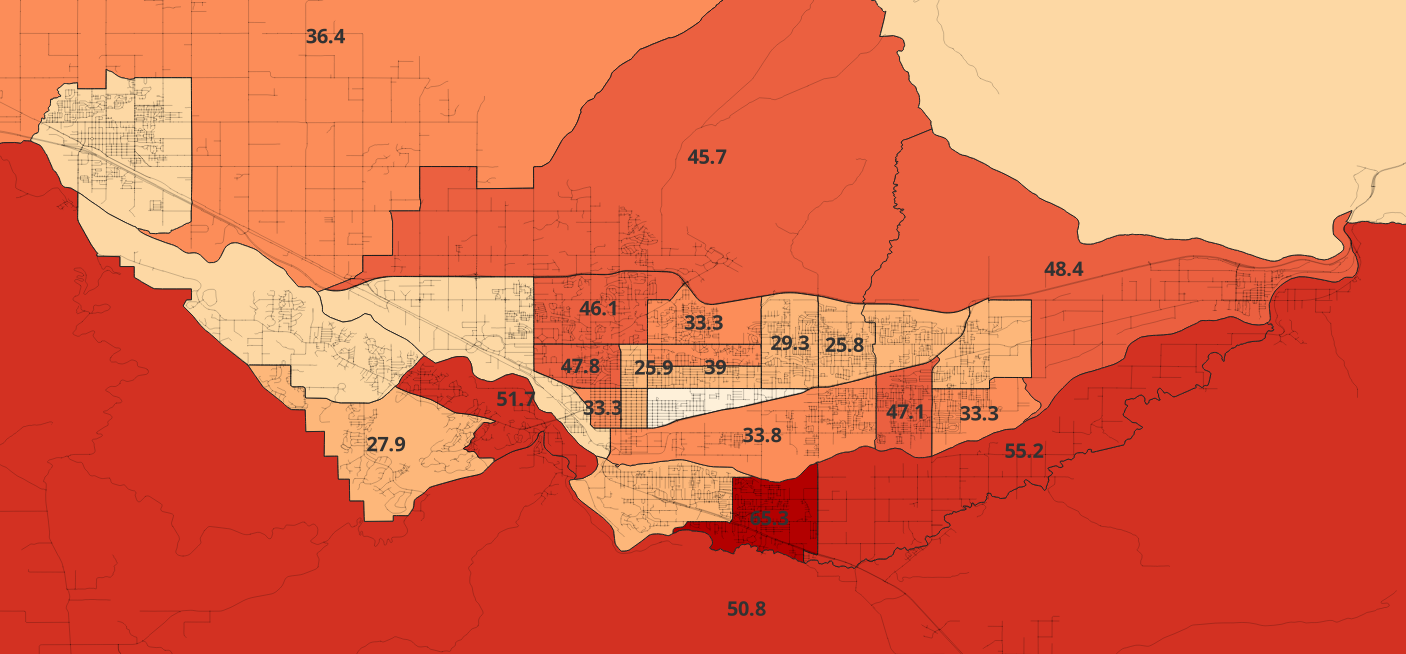
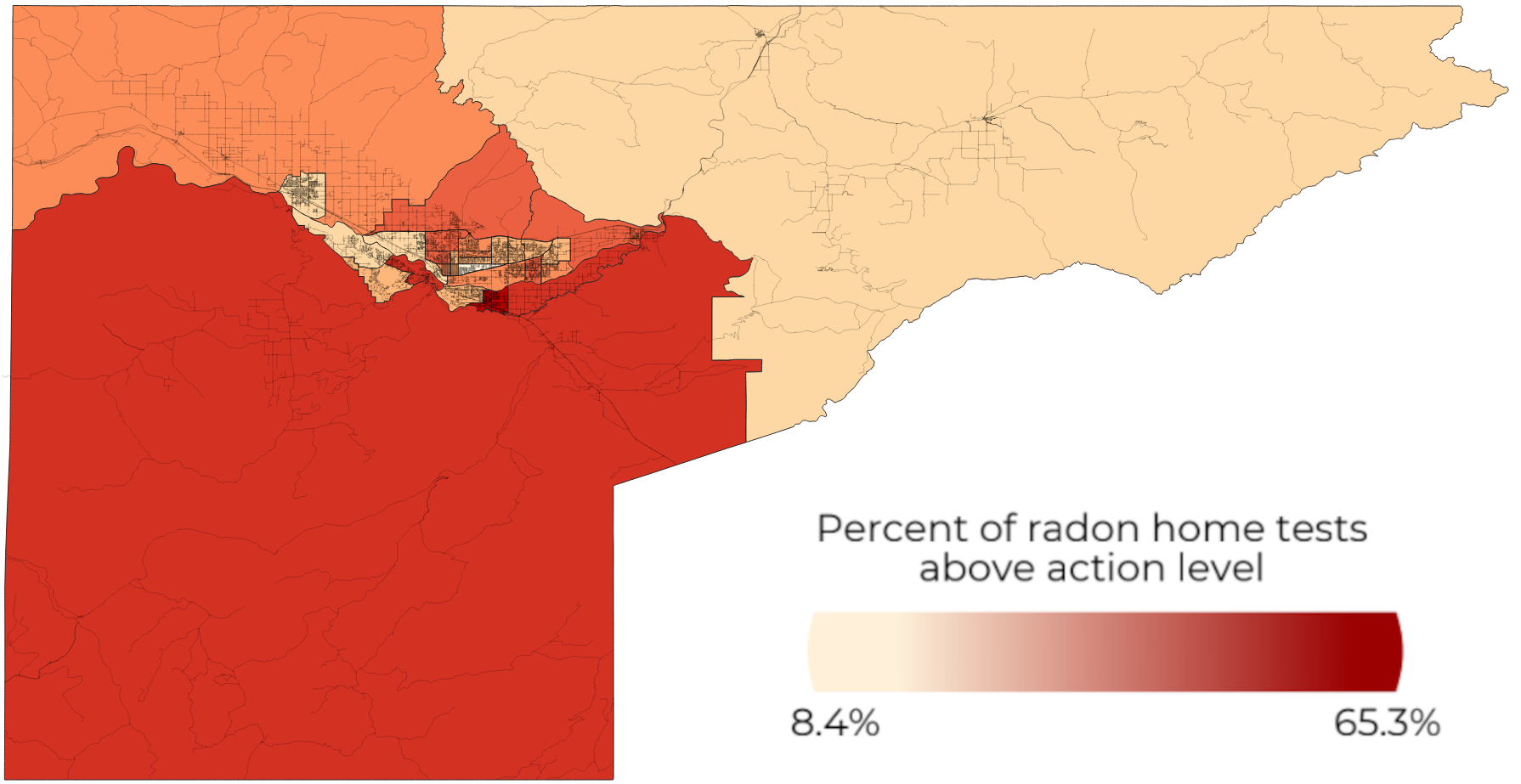
Urban view (top) rural view (bottom) of percent of radon home tests above Colorado’S 4pcl/L Action Level (2005-2022) The darker color the higher the percentage of radon home tests above the 4pCI/L action level. Regions with a percentage above 25% are labeled in the urban view.
Water Quality
Mesa County Public Health’s water quality lab provides testing services for the Western Slope. Between 2021 and 2023, the MCPH Water Quality lab processed 10,863 samples from 17 counties in Colorado. The MCPH lab tests for coliform bacteria, which must be completed several times per year. Without the local lab, samples from the Western Slope would be sent to labs several hours away for analysis, adding time and expense.
In 2022, CDPHE tested various Mesa County drinking water sources that in total serve over 60,000 residents. All sites were below acceptable thresholds for the eleven contaminants, indicating that they were safe to drink.
Air Quality
Air quality is an increasingly important issue to local residents. This is especially true when the air is conspicuously smoky during the intensifying wildfire seasons across the western United States and agricultural burn seasons within the Grand Valley.
Mesa County has two main pollutants that cause unhealthy air quality, ozone and particulate matter.
Ozone is formed from two non-visible pollutants:
- nitrogen oxides (NOx) commonly emitted from vehicles and power plants, and
- volatile organic compounds (VOCs) emitted from vehicles, factories, gas stations, and paints.
When these components combine with sunlight, the product becomes visible as smog.
In addition to ozone, the other common pollutant is particulate matter. Particulate matter can be made up of particles emitted from construction sites, unpaved roads, fires, and dust from wind. Particulate matter can also be made of chemical pollutants emitted from power plants, industries, and automobiles.
The size of particles is directly linked to their potential for causing health problems. Small particles less than 10 micrometers in diameter pose the greatest problems. They can get deep into the lungs, and some may even get into the bloodstream. Exposure to such particles can affect both the lungs and the heart.
People with heart or lung diseases, children, and older adults are the most likely to be affected by particle pollution exposure.
As overall air quality degrades, those with lung-related health issues like asthma or chronic obstructive pulmonary disease (COPD) will be affected sooner than others.
Mesa County has had very few days in recent years where air quality was unhealthy for the general population. Even for sensitive individuals only 1.1% of the days in the last three years would have been of concern. However, for those who are sensitive those days can be very stressful.
Air quality days 2013 to 2023
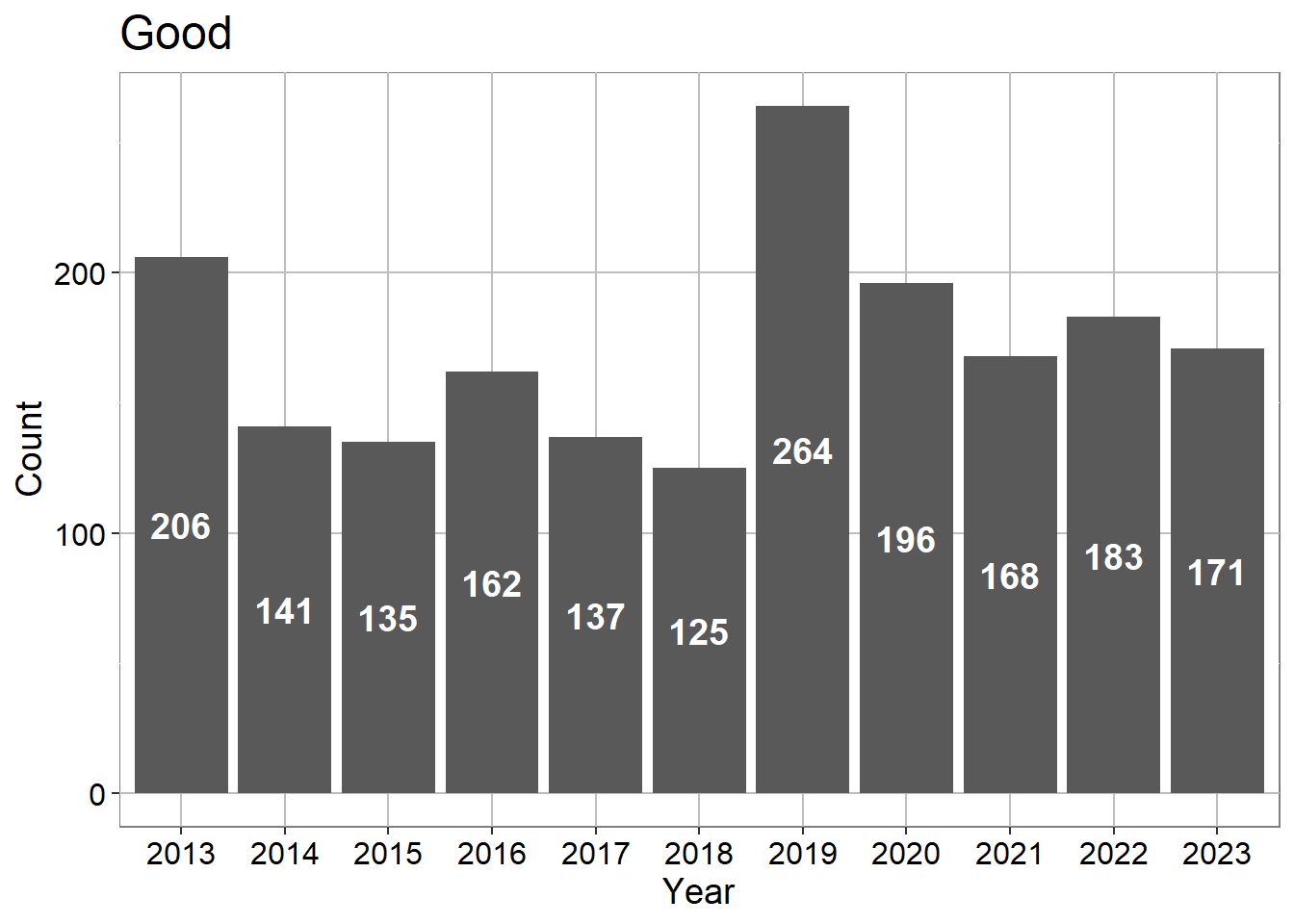

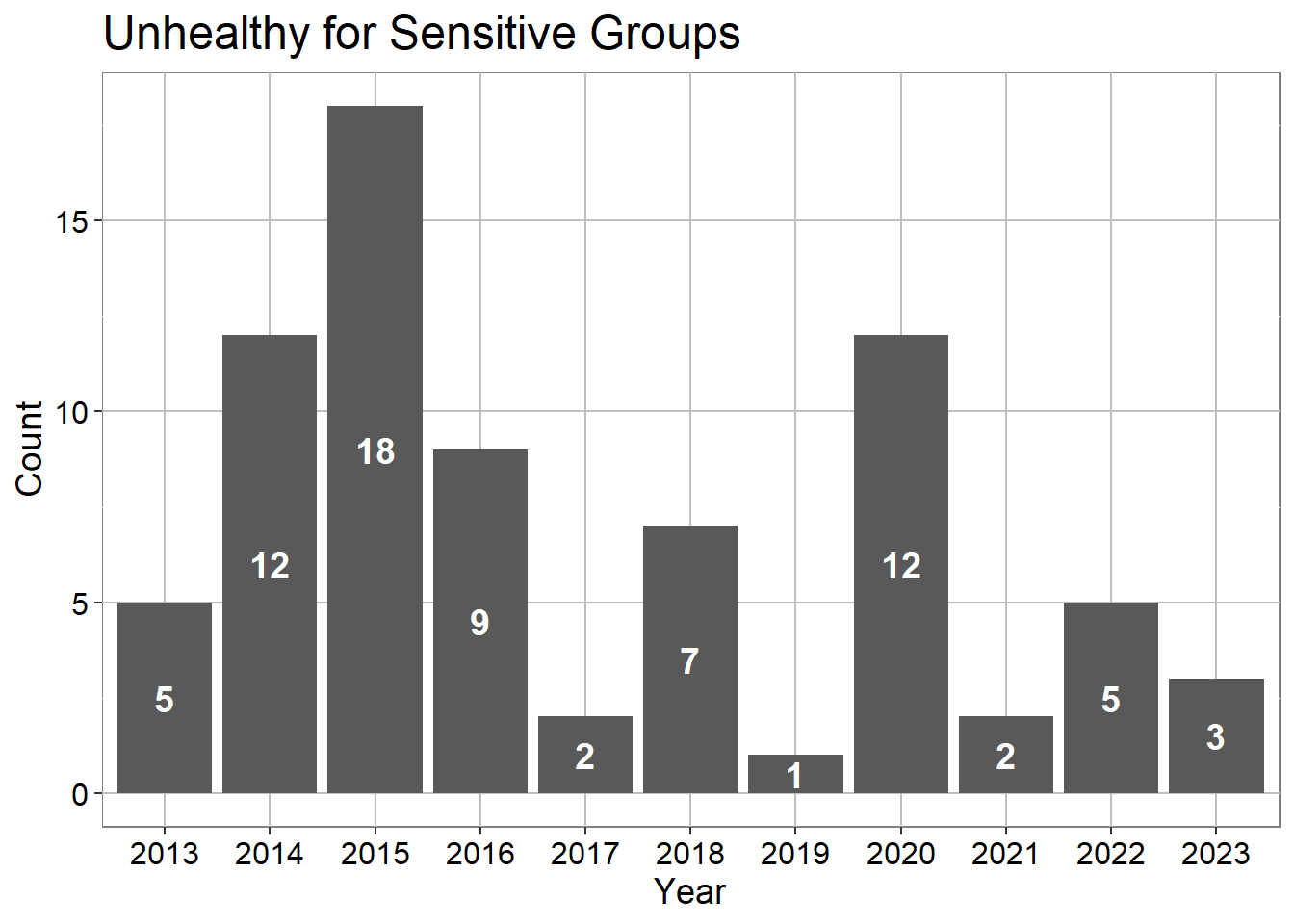

Air quality days 2013 to 2023
| Year | 2013 | 2014 | 2015 | 2016 | 2017 | 2018 | 2019 | 2020 | 2021 | 2022 | 2023 |
| Good | 206 | 141 | 135 | 162 | 137 | 125 | 264 | 196 | 168 | 183 | 171 |
| Moderate | 153 | 211 | 211 | 194 | 226 | 232 | 100 | 157 | 193 | 177 | 191 |
| Unhealthy for Sensitive Groups | 5 | 12 | 18 | 9 | 2 | 7 | 1 | 12 | 2 | 5 | 3 |
| Unhealthy | 1 | 1 | 1 | 1 | 0 | 1 | 0 | 1 | 2 | 0 | 0 |
Since 2017 there has been a slight increasing trend in the number of “Good” air quality days; however, local area wildfires can produce clusters of days where the air quality becomes unhealthy for sensitive groups or worse.
Only 16.7% days of moderate or worse air quality occurred during the county’s official burn season, March 1 to May 31 and Sept 1 to October 31. Agricultural burning may occur at any time of the year.
Days of Moderate or Worst by month

Days of Worst than Moderate by Month

Moderate or Worst Air Quality by Month
| Season | 1 | 2 | 3 | 4 | 5 | 6 | 7 | 8 | 9 | 10 | 11 | 12 |
|---|---|---|---|---|---|---|---|---|---|---|---|---|
| Off Season | 5.8 | 3.4 | 5.8 | 5.8 | 4.7 | 4.9 | 5.4 | |||||
| Burn Season | 1.9 | 3.3 | 5.4 | 3.7 | 2.5 |
Worst than Moderate Air Quality by Month
| Season | 1 | 2 | 3 | 4 | 5 | 6 | 7 | 8 | 9 | 10 | 11 | 12 |
|---|---|---|---|---|---|---|---|---|---|---|---|---|
| Off Season | 0.5 | 0 | 0 | 0 | 0.2 | 0.1 | 0.1 | |||||
| Burn Season | 0 | 0.3 | 0 | 0 | 0 |
Retail Food inspections
Mesa County has approximately 750 retail food establishments. Between 2021 and 2023, MCPH completed 1,594 retail food inspections, 1,008 of which were routine inspections.
Routine inspections resulted in 898 passing outcomes, 107 re-inspections, and three closures. MCPH conducted 115 inspections in response to a complaint.
Inspections are conducted on a risk-based schedule. Most full-service restaurants are inspected one time per year as long as they successfully pass the routine inspection. If they require reinspection, they are subsequently inspected more frequently.
In addition, MCPH provides licenses for approximately 100 food vendors at over 50 special events throughout the year.
Transportation
In the 2022 Tell Us Community Survey, 31% of residents identified improving transportation infrastructure as a top priority for county leadership. Residents living in urban areas were more likely to select transportation infrastructure as a priority in future planning, 33% of urban residents compared to 24% of rural.
Fruita residents were notably more satisfied with transportation options in their area. 71% of Fruita residents were satisfied with bikeability, compared to 47% living elsewhere. 66% of Fruita residents were satisfied with walkability compared to 42% of residents living elsewhere in the county.
19% of Clifton residents were satisfied with road conditions, compared to 29% of residents living elsewhere. Since the survey was completed, several major roadwork projects have been undertaken in the Clifton area.
In Mesa County, a serious injury crash occurs approximately every five days and a fatal crash happens approximately every 21 days. Speeding was a factor in 44% of rural fatal and serious injury crashes and 22% of urban fatal and serious injury crashes. Impairment is a factor in 22% of rural fatal and serious injury crashes and 23% of urban fatal and serious injury crashes.
594 people lost their lives or were seriously injured on Mesa County roads between 2016 and 2022. Thousands more were impacted by crashes.
Over this time period, a serious injury crash occurred approximately every five days, and a fatal crash happened approximately every 21 days.
Speeding was a factor in 44% of rural fatal and serious injury crashes and 22% of urban fatal and serious injury crashes.
Impairment was a factor in 22% of rural fatal and serious injury crashes and 23% of urban fatal and serious injury crashes.
CRASHES WITH A FATALITY OR SERIOUS INJURY, MESA COUNTY (2016-2022)
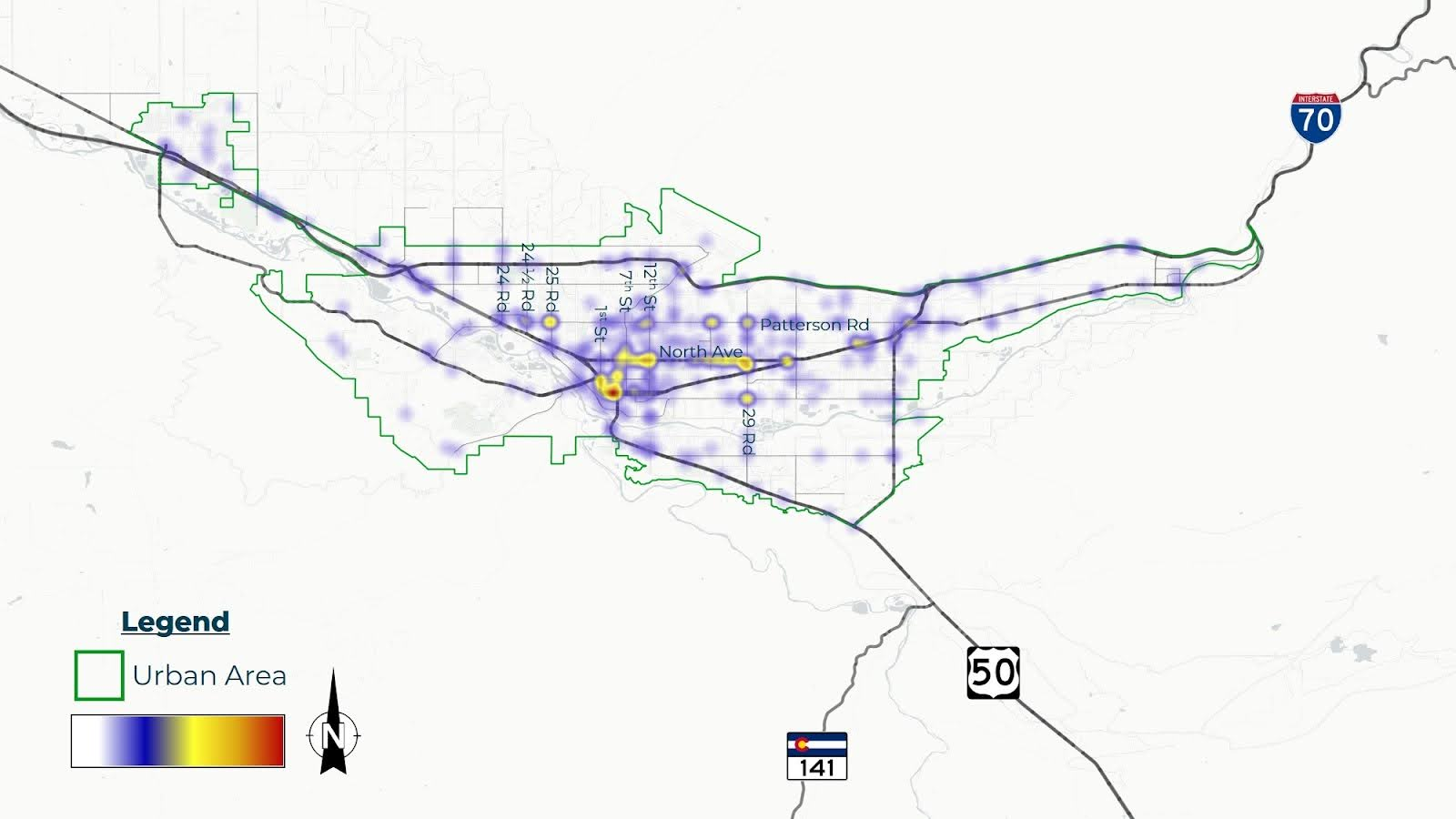
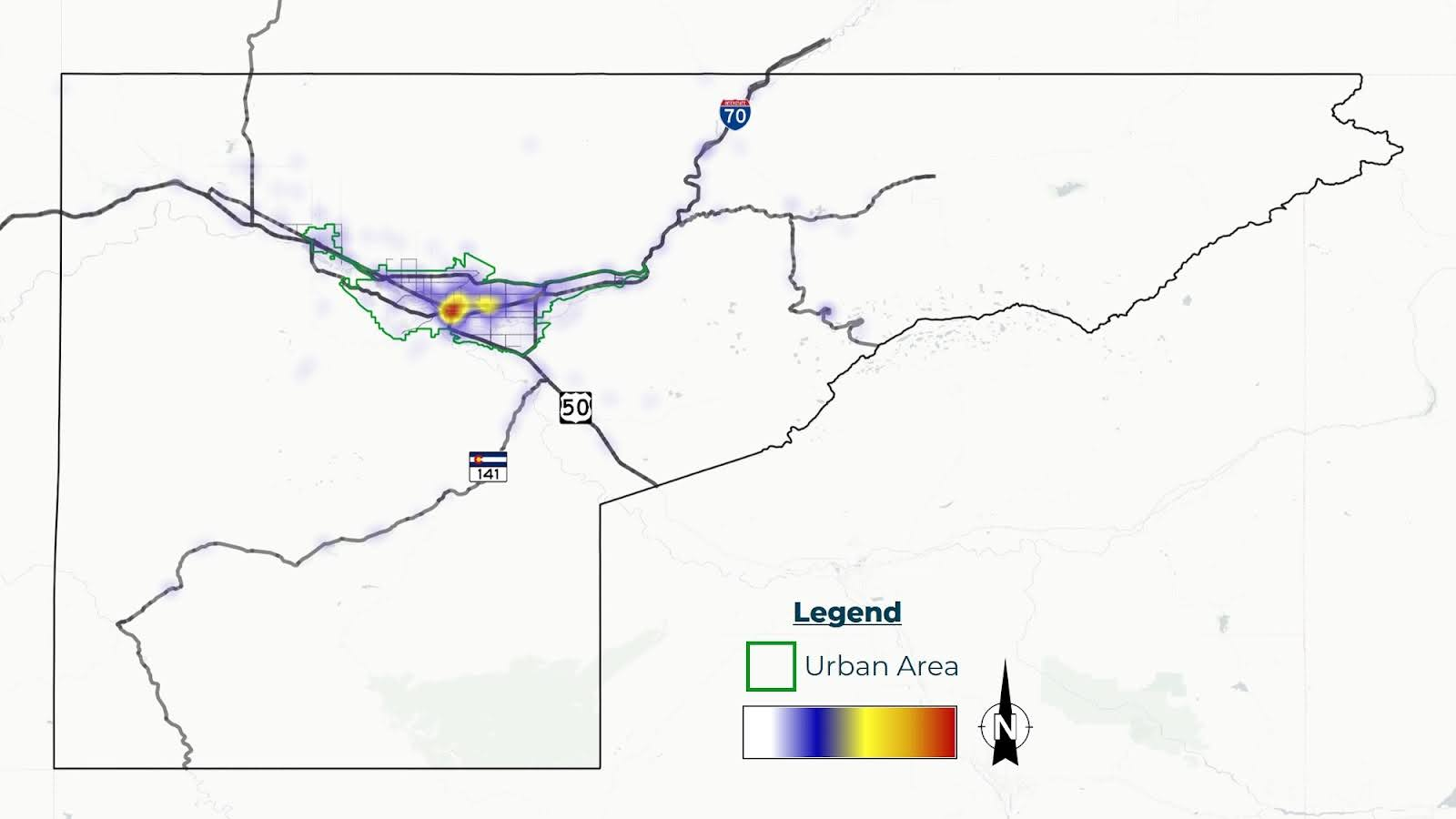
Urban view (top) and full county view (bottom)
Parks and Green Space
Mesa County is unique in the abundance of outdoor recreation opportunities available to residents, both in urban areas and throughout a wealth of rural public lands. Parks and green space hold tremendous power for improving physical, mental, and environmental health. Particularly among urban residents, parks offer natural spaces for increased physical activity and social connections, as well as protecting against urban environmental health threats such as air and noise pollution.
Outdoor recreation is an integral part of Mesa County culture, and 87% of residents use Mesa County parks and trails. The quality and number of parks and trails are among the highest rated community amenities.
By area, Mesa County is over 70% public land managed by the Bureau of Land Management and the U.S. Forest Service. Public lands include the Colorado National Monument and Grand Mesa National Forest. Mesa County public lands contain over 270 miles of non-motorized trails available for hiking, mountain biking, nordic and backcountry skiing, and horseback riding. Some of the more popular trail systems include Lunch Loops, North Fruita Desert 18 Road, Kokopelli, Palisade Rim, and Gunnison Bluffs.
Park and trail usage is nearly ubiquitous among all ages of Mesa County residents but does decrease slightly with age. About 80% of adults over 60 report using parks and trails, compared to nearly all adults under 40. From the 2022 Tell Us Community Survey, outdoor recreation among older adults was notably correlated with higher satisfaction with quality of life and greater social connectedness. Older adults who use parks and trails are more likely to:
- agree that Mesa County is a good place to live,
- have more friends they stay in regular contact with, and
- say they feel close to their neighbors.
 Proximity and Income
Proximity and Income
 Additional Resources
Additional Resources
 Healthy School Meals for All
Healthy School Meals for All
 Public Safety Prioity
Public Safety Prioity
 Mesa County Community Cleanups
Mesa County Community Cleanups